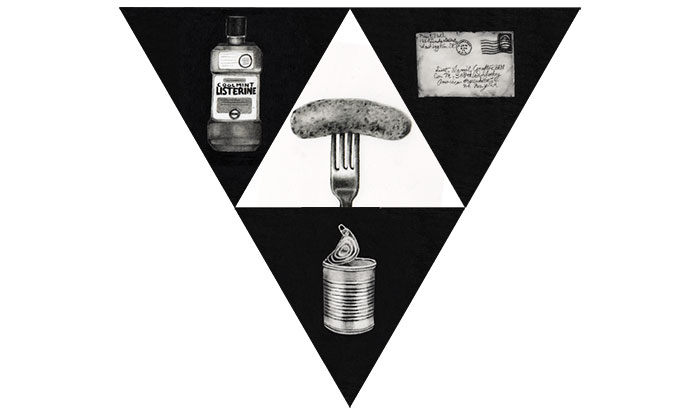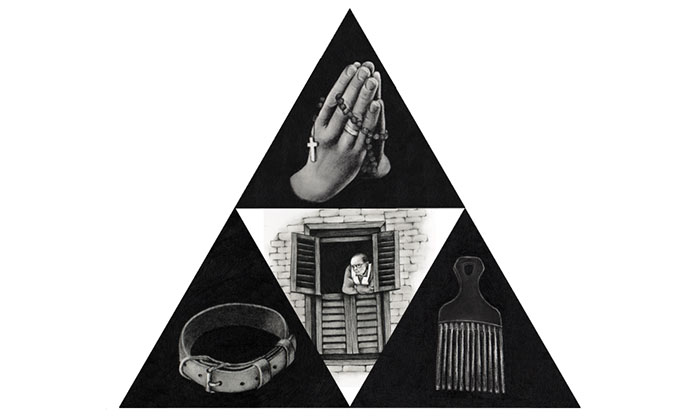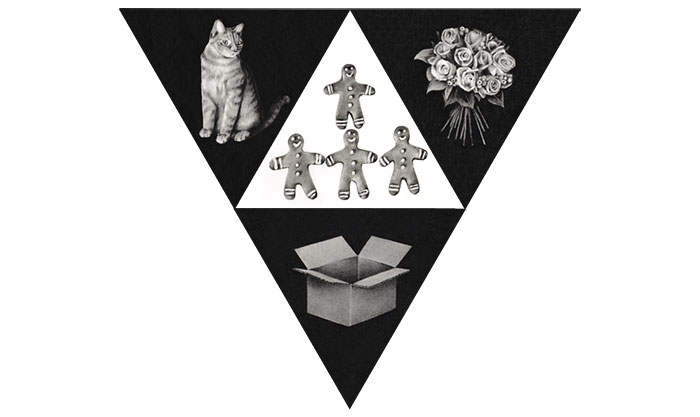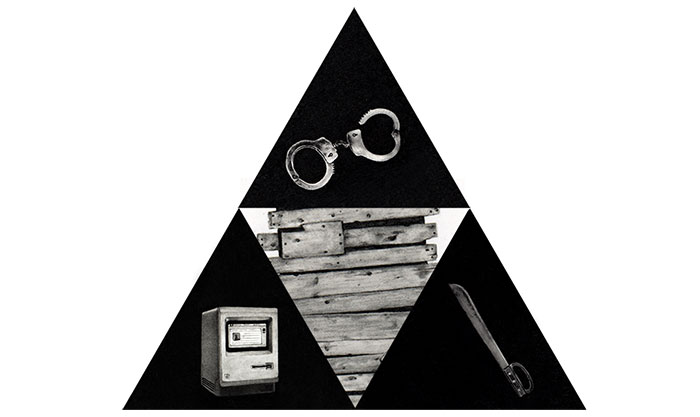The Life of a Zombie
He and I moved in together a week ago, and I am still blown away by my feelings for him. I had given up after my last date ended with hostage negotiators yelling through a megaphone, Put the machete down, sir! at the shirtless, sweating maniac holding the blade to my throat on the roof.
A friend suggested I try a dating service, Perfect Love, and I spent one long day posting a picture of myself (in a tube top and spandex pants, gut hanging out, singing into a spatula) and answering question after question.
I was so honest, it took weeks for the service to respond with three candidates. My friend, in the interim, had met a guy who ran a B&B out of his mansion in Collingwood. He had a mouthful of veneers and called everyone “bro.”
My first date was with a man suffering, agonizingly, from necrotizing fasciitis, and I spent the day at his bedside, in a gown and mask, listening to him talk deliriously about the time he was a roadie for Tiny Kiss, as they amputated his legs.
So that guy died.
The next date was at the Kingston Penitentiary, with a pretty famous murderer. He and I talked through Plexiglas, and he was cuffed and shackled the whole time. He said I was too old for him, but would I put on a dirty puppet show involving girl-puppet-on-girl-puppet action?
I did the show, and he and I were so close to something special. I loved the way his eyes narrowed and turned into flat black buttons when he directed me: Now have the one girl shoot the other one! No, choke! Choke her!
But he lost his visiting privileges when a guard walked in while I was holding the puppet’s bare chest to the glass for him to kiss.
Finally, I met Bub.
Yes, Bub is a zombie, part of the Legion of the Undead. And yes, it is hard to keep him from trying to attack and eat me—or it was, until I got a zombie taser and turned him on to Thai food.
He lives in a room in the back I secure every night with whatever wood is around. In the day, he likes to lie in an elongated box I have filled with dirt while I throw him chicken heads and canned haggis.
The first word he learned was “love,” a word he also uses to refer to the neighbourhood animals he kills, and worse.
Bub had obviously been a handsome man once, and his black suit, white shirt, and floral tie look fine.
He gets tired easily, so I tend to go to bed early, taser him into his room, toss in a pile of white rats, and nail the door shut.
He loves the Discovery Channel, dancing to good tunes, and working out by running really fast with his arms outstretched.
Some nights when he is screaming Love! and swiping at the door, I sigh, like those days when God fills the sky with falling feathers and white spores, and the warm sun adores you, and you are moved enough to write I LOVE BUB in sidewalk chalk everywhere.
This is what I do now, mostly. This is my man.
The Forest

On a rainy fall night, Margaux and I went to an art exhibit about sustainability. The art was spread over a number of vacant lots: there were boxes filled with tin cans that damp, angry children were throwing at each other.
Is that art? we kept asking.
An old man passed out, twitching, about three metres from the installation. Art?
He was cradling a bottle of Listerine; his lips were ocean blue. The exhibit beside him was called Hobo Utopia. In Hobo Utopia, there are sausages and hot chocolate, and a lot of kindling.
A white beam of light pulsed WE ARE SORRY in Morse code.
People in giant paper bags crowded around us and apologized, too.
We had wanted to see the Forest, which was billed as a spectacle of recycled metal parts and a galaxy of lights. We were talking about steel trees glittering with frost and blackly banded together, which carved the light into ghosts.
We found it by the train tracks, in a field, on a scorched part of the grass.
It was an aluminum trailer with some cut trees in its interior. Overhead, there was the sound of hammers. The plaque suggested we would “emerge back into another part of the city.”
It took less than a minute to walk through the trailer and out, to nowhere new: the same officious volunteers with clipboards milling around, the same lonesome train bearing down and then away.
I started to wonder what other things I had missed while seeking out truth and beauty.
Margaux writes me letters from Yukon.
She went to a little museum and saw a stuffed fox. The night before, she had seen a red fox’s tail twitch, then dart like a flare. This happens a lot, she writes, seeing the same things, dead and living.
Hegel imagines beauty and truth as a compound, beginning when a caveman carved a little bison out of wood and did not pop it in his mouth.
She tells me that she is painting animals: one of a dog called The Miracle, and a basket of baby animals she is holding, fiercely, to her chest.
She has painted me without a shirt on, holding Frankie on a chair in the middle of a lake. I call the first study Heaven, and move it around my house, from nail to nail, restless to live inside of it.
Most days, I realize I have used up all of my love and feel resigned.
Or warm and contented—this fall, in the gold light and leaves, slowly detaching—with the love I have already had, and so much of it.
There would have been owls in the Forest, diving for scurrying creatures. Their eyes would have been made out of egg cartons, their feathers scraps of owl-coloured paper.
It was the Forest we could not see that told us about truth and beauty, and many of us missed it.
I am lonely for my friend Margaux, who could stand in the Forest we imagined, like a Crimson King maple, and explain photosynthesis so earnestly she would catch fire and cool in the dark rain and then be golden.
She is the light that lowers sweetly in the fall to break the blow of sad endings.
Snoopy

This Jack Russell I am telling you about was a bad dog, Jean tells me as she pours bread crumbs and two muffins from a bag.
The pigeons scramble over, flashing their purple tails.
This dog would bark at people and bite them, she says. Once I saw it bite the head off a bird!
She tells me this last part very quietly, so the pigeons cannot hear.
Anyways, so you see up there? she asks, pointing to the upper floors of the twenty-storey building that overlooks the park like a monstrous piece of beige Lego.
Well, one day she got so mad, the lady who owned the dog, that she just threw him from her window.
Then she jumped out right after him! They both died, of course.
Frank and I have met most of the people who walk in the park, some of whom scare us. Especially Cheryl, a vast stump of a woman who likes to let her pit bull off leash and laugh when I protest, shakily, that my dog is not very good with other animals.
Yeah, well this’ll learn him! she yells as I scoop Frank up and practically crab-walk to the street.
Some are harmless, crazy women, like the one who prays ceaselessly, who says the rosary all day while pacing the park, her eyes milky with anxious love.
Or the pantless woman who likes to stand and flex her ruddy ass cheeks and tease her bush with an Afro pick.
Or Dusty, who is having pieces of her internal organs removed, bit by bit. Shortly before she dies, she tells me that this is no kind of life. I’d rather pick fly shit out of pepper! she barks.
And then there is Alva, an old woman with a mangy poodle she calls Snoopy. She has been apprehensive about letting Frank near him, but after we talk a few times the two dogs play a bit, and I feel happy for my strange dog and his secret reasons for hating many things.
One day, Snoopy comes barrelling over with Alva in hot pursuit. He begins sniffing Frank, spending a fraction too long at his butt.
Snoopy! Alva screams, her face wild. You’re not that way! You’re not that way!
And she yanks her dog away from mine and streaks off, panting and still crying, No, Snoopy, no!
And then I walk my gay dog home, past the paths of clover, violets, and buttercups.
Life With Billy Joel

We are always at cross-purposes, talking at each other, listening in our own way. On a typical night, he will tell me, again, about writing his songs, and I will recall the mordant details of my day.
Today he was baking when I came in. I was cold, and very tired. I had taught my Reading Popular Culture class, which went pretty well, discounting the audible, laryngeal boredom of the feral girl I despise.
Billy Joel is taking trays of gingerbread out of the oven, nodding and humming. He is wearing bifocals, and his tufted silver hair is matted; his little concert T-shirt rides his hard, round belly.
Come here, Scribbles, he says, opening his arms. He has a number of sweet nicknames for me: Pink Lady, Word Worm, Four Eyes, Goofball, and the Vast, Fathomless Tenderness.
He writes the latter on the little cards that accompany the flowers he sends me when he is touring; he uses it in conversations, as in, Don Henley! Please get the Vast, Fathomless Tenderness a drink, and step on it!
I let him hug me, then break away.
It is hard to write about Billy Joel and me. Because it is private, because no one needs to know how it is when Anthony says, Go ahead with your own life, leave me alone.
Anthony is a metaphor, he will say.
People are afraid, mostly. They want to escape their pasts and start over.
Who needs a house out in Hackensack? Billy Joel sings, absent-mindedly, as he draws bricks on the gingerbread. He is making a replica of his childhood house in Hicksville. He cooked and shaped his family, and me, the day before.
But I wasn’t there, I had protested.
Really, Lynn, you surprise me sometimes, he said.
He is chronically disappointed in my lack of imagination.
During the slide show I gave my class today, I closed my eyes: This is me and my friends at a club on Saint-Laurent, and we are hearing “London Calling” for the first time… That is my hand, in Carol’s—there are snakes on our wrists, dragons… This is us, later, lying together on a long table at the stripper’s place, and the stripper says, Oh, such exotic beauty!
The moon takes the black sky as in a chess move, and stars fall inside of us, illuminating our beauty, but we do not see ourselves this way.
We are worried about what will happen.
That is the way one young man smelled, like cedar and salt… This is how his silky black hair fell, like a wave in the middle of the ocean where I got shipwrecked—
What did you really show them? asks Billy Joel, who is now sitting with the cats on his lap, our two cats and three I have never seen before.
Michael’s injuries, I say. Michael’s back, rippling beneath a gold satin bodysuit. Michael making devil horns with his fingers and smiling lazily. Michael—
You still miss him, he says.
It’s not that, I say. I just think of him and dream of him sometimes.
Tell me about it, he says.
The night I fell in love with Michael, he said, I will never leave you. He wrote this on every box he ever packed: I am never coming back. And I have been alone ever since.
Like this? Billy Joel asks, mauling my neck with his rough beard.
I turn around.
Voila! he says, and I shake away the clouds. He is holding out a tray and smiling.
The house—now spackled with jelly beans and gumdrops—is done!
Excerpted from Life Is About Losing Everything, published by House of Anansi Press. Copyright 2012 by Lynn Crosbie. Reprinted with permission.
This appeared in the April 2012 issue.




